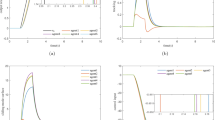Contents
This is the first paper to discuss the design and implementation of multiple fuzzy logic controllers in servo drives. Both ac and dc drives are considered since both types are used in high performance applications and their basic control structures are similar. The progressive development of single and multiple fuzzy logic controllers and detailed simulation and experimental results are presented for servo drives incorporating interacting fuzzy controllers. For the dc drive considered, the controllers are a speed controller, an armature current controller and a flux (field current) controller. In the case of the fully digital ac drive, a fuzzy speed controller is implemented in real time using the TI TMS320C30 DSP and is shown to provide stable, robust control. The design procedures and the drive responses are compared to those for conventional non-adaptive and self-tuning controllers. The advantages of a fuzzy approach to the design of variable speed drive systems are also discussed together with practical considerations for implementation.
Übersicht
Dies ist die erste Veröffentlichung, die den Entwurf und die Umsetzung von mehreren Fuzzy-Logik-Reglern für Servomotoren diskutiert. Sowohl Gleichstrom- als auch Asynchronmotoren werden betrachtet, da beide Motorentypen als hochleistungsfähige Antriebe verwendet werden und ihre grundlegenden Regelungskonzepte ähnlich sind. Die schrittweise Entwicklung von einzelnen und mehreren, sich gegenseitig beeinflussenden Fuzzy-Logik-Reglern, ausführliche Simulationen über das dynamische Verhalten so geregelter Antriebe und experimentelle Ergebnisse werden vorgestellt. Die für den Gleichstrommotor verwendete Regelung enthält einen Drehzahl-, einen Ankerstrom- und einen Erregerstromregler. Die Regelung des Asynchronmotors, die einen Fuzzy-Logik-Drehzahlregler enthält, wurde auf einem TI TMS320C30 DSP implementiert und erwies sich als stabil und robust. Die Entwurfsschritte und das Verhalten der so geregelten Motoren werden sowohl mit konventionell geregelten, nich adaptiven, als auch Regelungen mit selbst-tunenden Reglern verglichen. Die Vorzüge bei der Verwendung von Fuzzy Logik hinsichtlich des Entwurfs von drehzahl-variablen Antrieben werden zusammen mit praktischen Betrachtungen bei der Implementierung vorgestellt.
Similar content being viewed by others
Abbreviations
- CE :
-
change of error
- CO :
-
change of output
- E :
-
error
- NL, NM, NS, NZ :
-
linguistic variables-negative large, negative medium, negative small, negative zero
- PL, PM, PS, PZ :
-
linguistic variables-positive large, positive medium, positive small, positive zero
- f m :
-
viscous friction coefficient (Nmsrad−1)
- i a ,i f :
-
armature and field currents, respectively (A)
- J m :
-
moment of inertia (kgm2)
- K a ,K c :
-
motor constants
- L a ,L f :
-
armature and field inductances, respectively (H)
- R a ,R f :
-
armature and field resistances, respectively (Ω)
- T ext :
-
external torque (Nm)
- u a ,u f :
-
armature and field voltages, respectively (V)
- μ:
-
membership function
References
Vas, P.: Eelectrical Machines and Drives: A Space-Vector Theory Approach, Oxford University Press, 1992
Vas, P.: Vector Control of AC Machines, Oxford University Press, 1990
Stronach, A. F.; Vas, P.: Variable-speed drives incorporating interacting multi-loop adaptive controllers, Proc IEE, Part D, July 1995
Stronach, A. F.;Vas, P.;Lees, P.: Self-tuning adaptive control of variable-speed drives, PCIM, Nürnberg, 1994
Vas, P.; Li, J.; Stronach, A. F.; Lees, P.: Artificial neural network-based control of electromechanical systems, 4th European Conference on Control, IEE, Coventry, 1065–1070, 1994
Vas, P.; Chen, J.; Stronach, A. F.: Application of improved fuzzy tuned and fuzzy controllers in variable-speed drives, IEE Control '94, Coventry, 1501–1506, 1994
Du, T.;Vas, P.;Stronach, A. F.: Design and application of extended observers for joint state and parameter estimation in highperformance ac drives, Proc IEE, Part B, 71–78, 1995
Zadeh, L. A.: Fuzzy Sets, Information Control, Vol. 8, 338–353, 1965
Zadeh, L. A.: Toward a theory of fuzzy systems in aspect of network and system theory by R. E. Kalman and N. Declaris, Ed., New York: Holt, Rinehart and Winston, 469–490, 1971
Zadeh, L. A.: A rational for fuzzy control. Trans. ASME, J. Dynamic System Measurement Control, Vol. 94, 3–4, 1972
Mamdani, E. H.: Application of fuzzy algorithms for simple dynamic plant, Proc. IEE, Vol. 121, no. 12, 1585–1588, 1974
Lee, C. C.: Fuzzy logic in control systems: fuzzy logic controller-Part 1, IEEE Trans. Syst. Man. Cybern. Vol. 20, 404–418, 1990
Lee, C. C.: Fuzzy logic in control systems: fuzzy logic controller—Part 2, IEEE Trans. Syst. Man. Cybern. Vol. 20, 419–435, 1990
Mamdani, E. H.: Advances in the Linguistic Synthesis of Fuzzy Controllers, International Journal of Man-Machine Studies, Vol. 8, 669–678, 1976
Procyk, T. J.;Mamdani, E. H.: A linguistic self-organising process controller, Automatica, 15, 15–30, 1979
Kosko, B.: Neural networks and fuzzy systems: a dynamical systems approach to machine intelligence, Prentice Hall, 1992
Author information
Authors and Affiliations
Rights and permissions
About this article
Cite this article
Vas, P., Stronach, A.F. & Neuroth, M. Design and DSP implementation of fuzzy controllers for servo drives. Electrical Engineering 79, 265–276 (1996). https://doi.org/10.1007/BF01245878
Received:
Issue Date:
DOI: https://doi.org/10.1007/BF01245878




